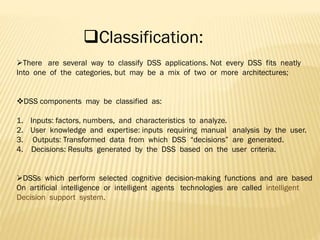Decision support system
- 1. DECISION SUPPORT SYSTEM Noreeha atique. (1062) Ummae farwa. (1007) Submited to Inam-ul-haq. University of education Renala campus BS(HONS)IT Morning
- 2. ?contents ?Define DSS ?components ?classification ?Application ?Benefits ?DSS characteristics and capabilities ?References
- 3. ?DSS: DSS are a specific class of computerized information system that supports Business and organizational decision-making activities. A properly designed DSS is an Interactive software-based system intended to help decision makes compiler useful information from raw data, documents, personal knowledge, and/or business models to identify and solve problems and make decision. ?Sprague (1980) defines DSS by its characteristics: ?DSS tends to be aimed at the less well structured, underspecified problem that Upper level managers typically face; ?DSS attempts to combine the use of models or analytic techniques traditional Data access and retrieval functions; ?DSS specifically focuses on features which make them easy to use by noncomputer people in an interactive mode; And ?DSS emphasizes and flexibility and adaptability to accommodate changes in the Environment and decision making approach of the user;
- 5. ?COMPONENTS:- Three fundamental components of DSS architecture are: 1) The data base (or knowledge base); 2) The model .i.e., (the decision context and the user criteria); and 3) The user interface. ? The user themselves also are also important components of architecture.
- 7. ?There are several way to classify DSS applications. Not every DSS fits neatly Into one of the categories, but may be a mix of two or more architectures; ?DSS components may be classified as: 1. Inputs: factors, numbers, and characteristics to analyze. 2. User knowledge and expertise: inputs requiring manual analysis by the user. 3. Outputs: Transformed data from which DSS Ī░decisionsĪ▒ are generated. 4. Decisions: Results generated by the DSS based on the user criteria. ?DSSs which perform selected cognitive decision-making functions and are based On artificial intelligence or intelligent agents technologies are called intelligent Decision support system. ?Classification:
- 8. ?Applications ?One is the clinical decision support system for medical diagnoses. Other examples Includes bank loan officer verifying the credit of a loan applicant or an engineering Firm that has bids on an several projects and wants to know if they can be Competitive with their costs. ?DSS is extensively used in business and management. Executive dashboard and other business performance software allow faster decision making, identification of negative trends, and better allocation of business resources. Due to the DSS all information from any organization is represented in the from of chart , graphs which helps the Management to take strategic decision. ?DSS are also prevalent in forest management where the long planning time frame demands specific requirements. All aspects of forest management , from log transportation , harvest scheduling to sustainability and ecosystem protection have been addressed by modern DSSs.
- 9. ? A specific example concern the canadian national railway system, which tests its equipment on a regular basis using a decision support system. A problem faced by an rail road is worn-out or defective rails, which can result in hundreds of derailments per year. Under a DSS, CN managed to decrease the incidence of Derailments at the same time other companies were experiencing an increase. ?BENEFITs ?Improves personal efficiency. ?Speed up the process of decision making. ?Increases organizational control. ?Encourages exploration and discovery on the part of the decision maker. ?Speeds up problem solving in an organization. ?Facilitates interpersonal communication. ?Promotes learning or training. ?Generates new evidence in support of the decision. ?Creates a competitive advantage over competition. ?Reveals new approaches to thinking about the problem space. ?Helps automate managerial processes. ?Create innovative ideas to speed up the performance.
- 10. ?DSS characteristics and capabilities ?Solve semi-structured and unstructured problems. ?Support manager at all levels. ?Support individuals and groups. ?Interdependence and sequence of decisions. ?Support intelligence, choice, design. ?Adaptable and flexible. ?Interactive and ease of use. ?Interactive and efficiency. ?Human control of the process. ?Ease of development by end user. ?Modeling and analysis. ?Data access. ?Standalone and web-based integration. ?Support varieties of decision processes. ?Support varieties of decision trees. ?Quick response.
- 11. ?REFRENCES ?Decision support system./wikipedia, the free encyclopedia.htm ?http://www.openspace-online.com/openspace-online_ebook_en.pdf ?Sprague , R.H. And E.D.Carlson(1982). Building effective decision support systems. Englewood cliffs, N.J., Prentice-hall. ?What is a DSS?The on-line Executive Journal for data-intensive Decision support.











